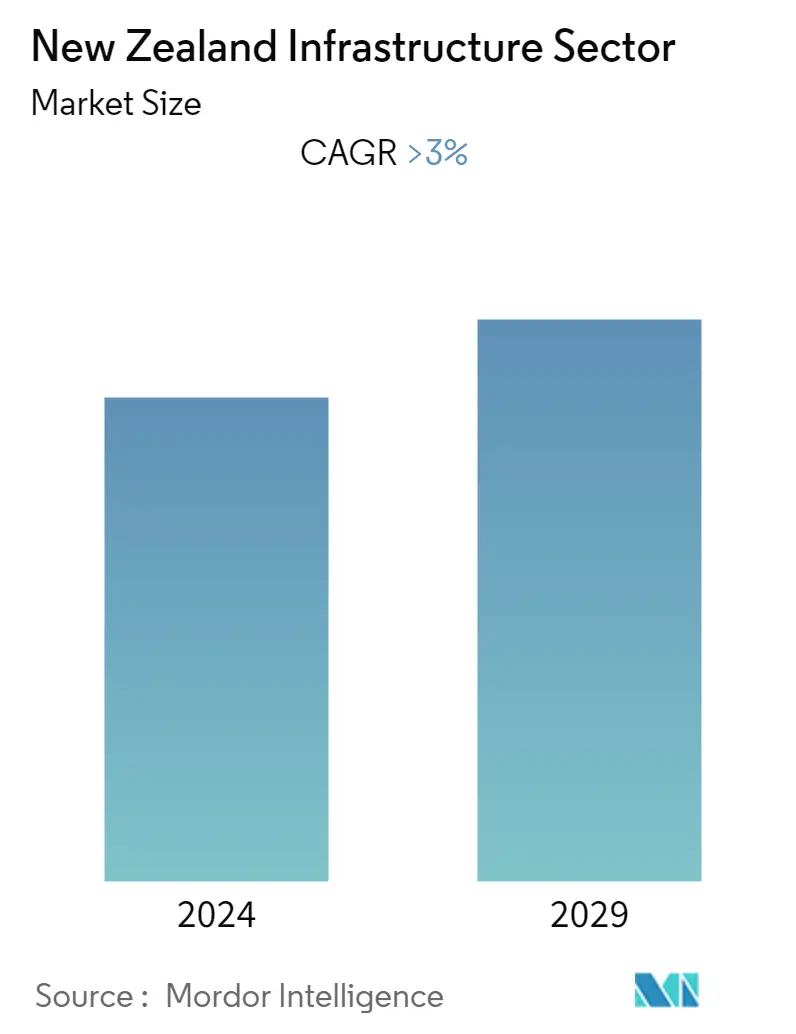Market Size of New Zealand Infrastructure Sector

| Study Period | 2020 - 2029 |
| Base Year For Estimation | 2023 |
| Forecast Data Period | 2024 - 2029 |
| Historical Data Period | 2020 - 2022 |
| CAGR | 3.00 % |
| Market Concentration | Low |
Major Players
*Disclaimer: Major Players sorted in no particular order |
New Zealand Infrastructure Sector Market Analysis
The infrastructure sector in New Zealand is expected to register a CAGR of over 3% during the forecast period (2023-2028).
- The COVID-19 pandemic impacted the infrastructure industry in the country. The construction activity in the infrastructure sector declined in Q2 2020. In addition, in Q2 2022, vertical infrastructure, which was majorly driven by private investment, experienced a 26% decline in activity compared to the same period in 2019. The infrastructure sector is currently recovering from the pandemic.
- Transportation is one of the major sub-sectors of the country's infrastructure sector. The sector is witnessing significant growth, majorly driven by increasing investments. For instance, in September 2021, more than USD 24 billion in investment was planned for New Zealand's land transport system for the next three years. The total fund includes USD 15.6 billion from National Land Transport Fund (NLTF) and USD 4.6 billion from the local government. In addition, the government invested USD 3.8 billion in additional Crown funding to deliver specific programs through the NLTP.
- Auckland is witnessing lucrative growth in infrastructure projects and creating huge opportunities for private capital, consultants, and developers. The city is registering significant investments in the transport infrastructure sector. In addition, in May 2022, the Auckland Light Rail (ALR) provided opportunities for professional services and consultancy services to procure the project. The project's estimated cost is NZD 14.6 billion (USD 9.3 billion), currently considered New Zealand's largest and most complex infrastructure project. Thus, the increasing investments and sustainable projects will likely drive the infrastructure sector in the country.
New Zealand Infrastructure Sector Industry Segmentation
Infrastructure is the backbone of domestic and international commerce and industrial and agricultural production. It is the fundamental organizational and physical framework necessary to operate a firm successfully. Basic infrastructure in an organization or a nation comprises communication and transportation, sewage, water, a health and education system, safe drinking water, and a monetary system. The report includes a complete background analysis of the New Zealand infrastructure sector, including the assessment of the economy and contribution of sectors in the economy, market overview, market size estimation for key segments, and emerging trends in the market segments, market dynamics, and geographical trends, and COVID-19 impact.
The infrastructure sector in New Zealand is segmented by type (social infrastructure (schools, hospitals, defense, and other infrastructure), transportation infrastructure (railways, roadways, airports, ports, and waterways), extraction infrastructure (oil and gas, other extraction (minerals, metals, and coal), utilities infrastructure (power generation, electricity transmission and distribution, water, gas, and telecoms), manufacturing infrastructure (metal and ore production, petroleum refining, chemical manufacturing, industrial parks and clusters, and other infrastructure)) and key cities (Wellington, Auckland, and Hamilton). The report offers the market sizes and forecasts in value (USD million) for all the above segments.
| By Infrastructure segment | |||||||
| |||||||
| |||||||
| |||||||
|
| By Key Cities | |
| Wellington | |
| Auckland | |
| Hamilton |
New Zealand Infrastructure Sector Size Summary
The infrastructure sector in New Zealand is poised for growth, with a positive outlook driven by increased investments and recovery from the impacts of the COVID-19 pandemic. The sector, particularly transportation, is experiencing significant expansion due to substantial funding from both national and local governments. Auckland is a focal point for infrastructure development, with major projects like the Auckland Light Rail offering opportunities for private capital and consultancy services. The government's commitment to sustainable and low-emission transport solutions, such as the installation of EV charging technology and the introduction of zero-emissions buses, underscores the sector's shift towards sustainability. This strategic focus is expected to enhance public transport usage and promote cycling, aligning with broader environmental goals.
The building and construction industry, a key component of New Zealand's infrastructure sector, is also witnessing robust growth. The private sector plays a dominant role in non-residential building initiatives, with significant contributions from commercial and educational projects. The government's emphasis on sustainable building standards, as part of the Carbon Neutral Government Programme, is shaping future commercial developments. The market is characterized by a fragmented landscape with major players like Obayashi Corporation Limited, Fulton Hogan Limited, and Hawkins Limited actively participating in upcoming projects. These developments, alongside the recovery and expansion of transportation infrastructure, are set to drive the sector's growth in the coming years.
New Zealand Infrastructure Sector Market Size - Table of Contents
-
1. MARKET INSIGHTS AND DYNAMICS
-
1.1 Current Economic and Construction Market Scenario
-
1.2 Impact of Government Regulations and Initiatives on the Industry
-
1.3 Supply Chain/Value Chain Analysis
-
1.4 Insights on Technology Snapshot and Digital Trends
-
1.5 Insights on Modernization of the Transportation Infrastructure Sector
-
1.6 Insights on Major Infrastructure Development Projects
-
1.7 Insights on Ongoing and Upcoming Infrastructure Projects
-
1.8 Market Dynamics
-
1.8.1 Market Drivers
-
1.8.2 Market Restraints
-
1.8.3 Market Opportunities
-
-
1.9 Porter's Five Forces Analysis
-
1.10 Impact of COVID-19 on the Market
-
-
2. MARKET SEGMENTATION
-
2.1 By Infrastructure segment
-
2.1.1 Social Infrastructure
-
2.1.1.1 Schools
-
2.1.1.2 Hospitals
-
2.1.1.3 Defence
-
2.1.1.4 Other Social Infrastructures
-
-
2.1.2 Transportation Infrastructure
-
2.1.2.1 Railways
-
2.1.2.2 Roadways
-
2.1.2.3 Airports
-
2.1.2.4 Waterways
-
-
2.1.3 Extraction Infrastructure
-
2.1.3.1 Power Generation
-
2.1.3.2 Electricity Transmission and Distribution
-
2.1.3.3 Water
-
2.1.3.4 Gas
-
2.1.3.5 Telecoms
-
-
2.1.4 Manufacturing Infrastructure
-
2.1.4.1 Metal and Ore Production
-
2.1.4.2 Petroleum Refining
-
2.1.4.3 Chemical Manufacturing
-
2.1.4.4 Industrial Parks and Clusters
-
2.1.4.5 Other Manufacturing Infrastructures
-
-
-
2.2 By Key Cities
-
2.2.1 Wellington
-
2.2.2 Auckland
-
2.2.3 Hamilton
-
-
New Zealand Infrastructure Sector Market Size FAQs
What is the current New Zealand Infrastructure Market size?
The New Zealand Infrastructure Market is projected to register a CAGR of greater than 3% during the forecast period (2024-2029)
Who are the key players in New Zealand Infrastructure Market?
Obayashi Corporation Limited, Fulton Hogan Limited, Hawkins Limited, Downer Group and Cpb Contractors Pty Limited are the major companies operating in the New Zealand Infrastructure Market.

